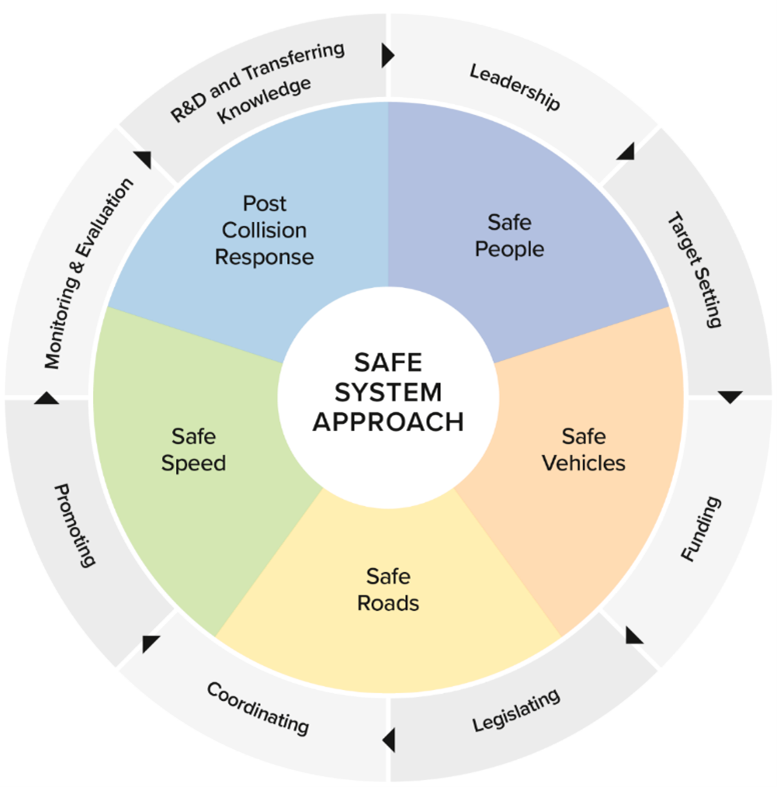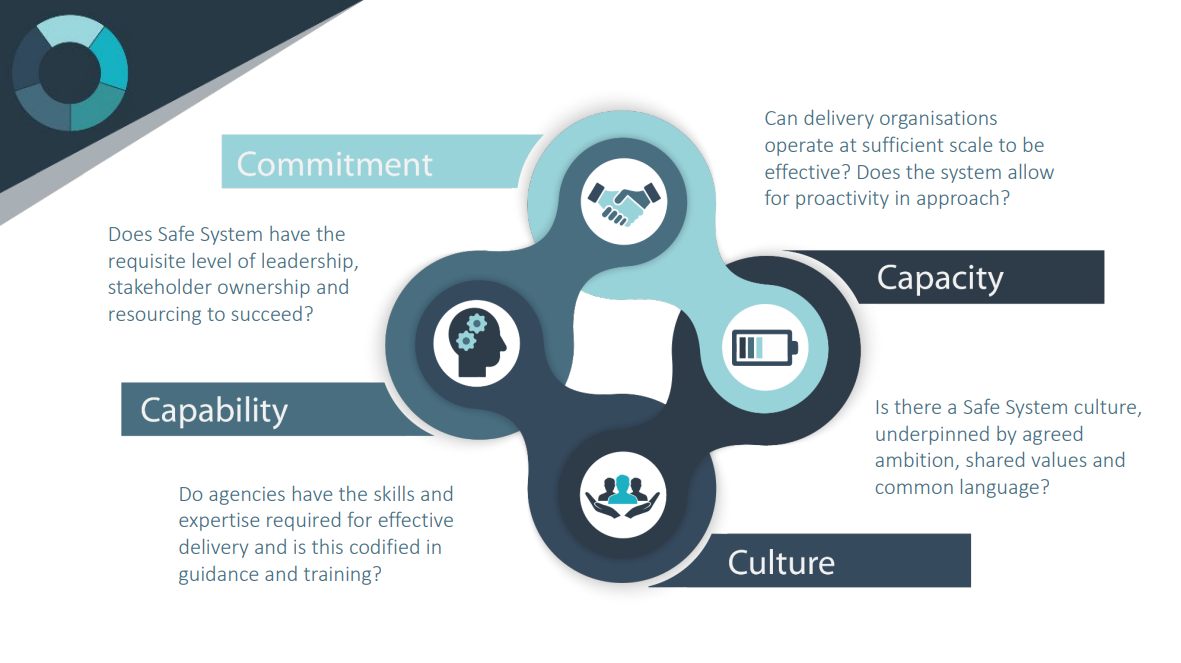Introduction
The outer layer of the Safe System Approach is crucial for the successful implementation and sustainability of road safety strategies. This layer includes elements such as leadership, target setting, funding, legislating, coordinating, promoting, monitoring and evaluation, research and development (R&D), and transferring knowledge. Each of these components supports the core inner principles of the Safe System, ensuring that road safety measures are effectively implemented and continuously improved.

Key Components
-
Leadership
- Importance: Strong leadership is vital for driving the road safety agenda, securing political commitment, and fostering a culture of safety. Leaders set the vision and provide direction, ensuring that road safety remains a priority.
- Role: Leaders advocate for necessary changes, allocate resources, and inspire stakeholders to work collaboratively towards shared safety goals.
- Target Setting
- Importance: Clear, measurable targets provide a framework for accountability and progress tracking. They help in focusing efforts and resources on key areas of improvement.
- Role: Establishing ambitious yet achievable targets for reducing road fatalities and injuries motivates continuous improvement and helps in assessing the effectiveness of interventions.
- Funding
- Importance: Adequate funding is essential to support the implementation of road safety measures, including infrastructure improvements, enforcement activities, and public awareness campaigns.
- Role: Securing sustainable funding ensures that road safety initiatives are not compromised and can be effectively maintained over the long term.
- Legislating
- Importance: Robust legislation provides the legal framework necessary to enforce road safety measures and regulate road user behaviour.
- Role: Enacting and updating traffic laws, regulations on vehicle standards, and penalties for non-compliance are critical for deterring unsafe behaviours and promoting a safe road environment.
- Coordinating
- Importance: Effective coordination among various stakeholders, including government agencies, local authorities, and community organisations, ensures that road safety efforts are harmonised and synergistic.
- Role: Coordination facilitates information sharing, joint planning, and the pooling of resources, leading to more comprehensive and efficient road safety strategies but also other road safety strategies.
- Promoting
- Importance: Raising public awareness and promoting road safety culture are key to changing behaviours and attitudes towards road safety.
- Role: Public campaigns, educational programs, and community engagement initiatives help in fostering a collective sense of responsibility and encouraging safer road use.
- Monitoring and Evaluation
- Importance: Continuous monitoring and evaluation are essential to assess the effectiveness of road safety interventions and identify areas for improvement.
- Role: Using data and performance indicators, stakeholders can track progress, adjust strategies, and ensure that road safety measures are delivering the desired outcomes.
- Research and Development (R&D)
- Importance: Ongoing research and development drive innovation in road safety, leading to the development of new technologies, practices, and policies.
- Role: Investing in R&D helps in understanding emerging risks, evaluating new interventions, and staying ahead of road safety challenges.
- Transferring Knowledge
- Importance: Knowledge transfer ensures that successful road safety practices and lessons learned are shared widely and adapted to different contexts.
- Role: Facilitating the exchange of information and best practices between regions and countries accelerates the adoption of effective road safety measures globally.
Bridging the Implementation Gap: Commitment, Capacity, Capability, Culture

The implementation gap between the outer layer and the core principles of the Safe System Approach is a critical challenge in achieving road safety objectives. This gap can be effectively addressed through a model focusing on Commitment, Capacity, Capability, and Culture.
Commitment
Importance: High-level commitment from political leaders and senior management is essential to drive the road safety agenda forward. Without firm commitment, initiatives may lack the necessary support and prioritisation, leading to inconsistent and ineffective implementation.
Action: Demonstrating commitment involves setting clear goals, allocating resources, and regularly communicating the importance of road safety to all stakeholders. Leaders must be visible champions of the cause, fostering a shared vision of safer roads.
Capacity
Importance: Building institutional capacity ensures that organisations involved in road safety have the resources, structures, and processes needed to implement and sustain safety measures.
Action: Enhancing capacity involves providing adequate funding, developing robust organisational frameworks, and ensuring that there is sufficient staffing and technical expertise to manage and execute road safety programs. This also includes investing in training and development for road safety professionals.
Capability
Importance: Developing technical and operational capabilities is crucial for effectively implementing road safety measures. This includes having the right tools, technologies, and methodologies to address safety challenges.
Action: Investing in state-of-the-art technologies, such as traffic management systems, data analytics tools, and modern road safety equipment, enhances capability. Additionally, fostering partnerships with research institutions and leveraging international best practices can help improve technical know-how and operational effectiveness.
Culture
Importance: A culture of safety is vital for ensuring that road safety principles are ingrained in the behaviour of all road users and stakeholders. A strong safety culture promotes shared responsibility and continuous improvement.
Action: Building a safety culture involves sustained public awareness campaigns, education programs, and community engagement initiatives that emphasise the importance of road safety. Encouraging proactive safety behaviours and recognising individuals and organisations that contribute to road safety can reinforce positive cultural change.
Importance of the Outer Layer
The outer layer of the Safe System Approach acts as the foundation for the core principles to function effectively. Without strong leadership, adequate funding, and robust legislation, the initiatives aimed at improving road safety would lack direction, resources, and enforcement. Similarly, without proper coordination, promotion, and monitoring, the efforts to enhance road safety would be fragmented and less impactful. Research and development, along with knowledge transfer, ensure that the Safe System Approach evolves with new insights and innovations, maintaining its relevance and effectiveness in reducing road fatalities and injuries.
Bridging the implementation gap between the outer layer and the core principles is crucial. This gap can be addressed through:
- Commitment: High-level commitment ensures road safety remains a priority.
- Capacity: Building institutional capacity provides necessary resources and structures.
- Capability: Enhancing technical and operational capabilities ensures effective execution.
- Culture: Fostering a culture of safety promotes proactive behaviours and shared responsibility.
By integrating these elements, the outer layer supports a holistic and sustainable approach to road safety, ensuring that all interventions work together to create a safer road environment for everyone in Jersey. This integrated approach bridges the implementation gap, allowing the Safe System Approach to achieve its full potential in reducing road fatalities and injuries.

